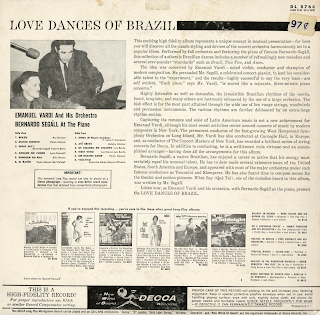Lara
Walk Softly/Run Wild!
Johnny Richards And His Orchestra
Coral Records CRL 57304
1960
Personnel on You Go To My Head, Sunday's Child, Run Wild, Yemaya, Tempest and Alone Together:
Trumpets - Burt Collins, Clyde Reasinger, Ray Copeland, Jerry Kail
Trombones - Billy Byers, Jim Cleveland, Jim Dahl
French Horn - Joe Singer
Tuba - Jay McAllister
Reeds - Dave Schildkraut (alto sax), Frank Socolow (tenor sax), Bill Slapin (bariton & piccolo), Shelly Russell (bass sax)
Rhythm - John Knapp (piano), Chet Amsterdam (bass), Ed Shaughnessy (drums), Ted Sommer (percussion)
Personnel on Walk Softly, The Way You Look Tonight
Same as above, with the exceptions of:
Trumpet - John Bello for Clyde Reasinger
French Horn - Julius Watkins for Joe Singer
Alto Sax - Gene Quill for Dave Schildkraut
Personnel on Laura, Three Cornered Cat
Same as on Walk Softly and The Way You Look Tonight with the exception of:
Percussion - Warren Smith, Jr. for Ted Sommer
From Billboard - February 1, 1960:
Richards is both smooth and dynamic in this fine offering of the big band brand of jazz. The arrangements are interesting and thoughtful, and they are well executed. The set has been well-recorded. Tunes include a few Richard's originals and some standards. Set is an excellent item for both pop and jazz jocks, and it should move for coin in both markets.From the back cover:
Johnny Richards is a man of convictions. Though calm, polite and soft-spoken, he is a leader. In 1957, he organized an orchestra because he had to. "As long as I can remember, I have been a frustrated jazz musician," Johnny told critic Bill Boss shortly after his orchestra came into being.
"I'd wanted to have an orchestra for some time," he informed me. "But I have been burned before, and it never seemed like the right time... It was Stan Kenton who gave me the final push. One day, he came up to see me a CBS and said:'John, you're a coward! Get a band. I know you want one. Why should I play your music when you can play it better yourself!'... That's all I needed... And by the way, Stan helped us get started. He's a wonderful man and so busy helping others. It's amazing that he has time for himself."
The Richards orchestra broke in at the Red Hill in New Jersey. Dom Cerulli, then Down Beat's New York editor, praised it to the skies. Favorable and unfavorable comment followed in other publications. But it was Down Beat editor Don Gold who hit the nail on the head in a discussion of Richards and his music.
"Composer/arranger Johnny Richards, it seems to me, is one of the ablest men to serve as a leader. He manifests a creative discipline and integrity so essential to accomplishment."
"Fronting a band of competent musicians," Gold continued, "musicians with definite solo potential, he manages to create an individualistic sound. It is a sound reflecting Richards' desires and musical aims..."
Richards' desires and musical aims out of an eventful, unclosed existence.
The Richards family was tremendously musical; Johnny's older brother was a symphony bassist; his mother, a pupil of Paderewski. After studying at the Troy (New York) Conservatory for a short while, young John hit the road at eight and a half with a vaudeville show, playing banjo, trumpet, and violin. Back from the vaudeville wars, he devoted himself to study in upstate New York, (he later studied in New York and Chicago) and began orchestrating professionally at 14. Johnny literally bicycled through the so-called "tender years."
In 1932, at 21, motion picture moguls in England showed a decided interest in the young composer/arranger. John accepted an offer from Gaumont Films and spent a year scoring their pictures. Returning to the U. S. in 1933, Richards went out to Hollywood to work at Paramount Pictures, serving as Victor Young's assistant. He stayed on to lot until 1940.
Then the band bug hit him and John had a scalding experience. Five years were spent and much money lost. "One day in Chicago, in 1945, I broke up the band; I had had it!" he explained.
Other mediums of expression were sought and found. In 1946, he became a contributor to the personality of the Boyd Raeburn orchestra. "This was a marvelous orchestra, a truly experimental unit," Johnny recalls. "I am especially partial to the edition that Boyd brought to New York to play at the Vanity Fair. Such great musicians sat in that band... Buddy DeFranco, Conrad Gozzo, Wes Hensel, Irv Kluger, etc..."
Putting to work his then budding "orchestra concept," employing many instruments indigenous to the symphony orchestra, Johnny wrote a number of memorable, full-sounding, impressionistic scores o which Prelude To The Dawn and Man With A Horn are among the most valuable.
"Around the time," Johnny went on, "I wrote some movie scores for pictures made in Mexico City and South America. The time spent in those places, and in Cuba later on, had a profound effect on me."
However, it was not until Richards came into the Stan Kenton organization in 1952, after more notable writing for Dizzy Gillespie, Charlie Barnet, Sarah Vaughn and Ella Fitzgerald, that the effect began to tell. His interest in Afro-Cuban rhythms culminated in the writing of Cuban Fire for Kenton in 1955, juxtaposing authentic Afro-Cuban rhythm against what Kenton has described as "North American music."
For Johnny, it was another beginning. His "orchestra" concept and what is best explained as an "out of the cubby-hole into the open attitude" had become defined. A coalescence of the two was apparent; a completely compatible marriage, a matter of time...Walk Softly
The Way You Look Tonight
Laura
Sunday's Child
Alone Together
You Go To My Head
Run Wild
Tempest On The Charles
Three Cornered Cat
Yemaya

























